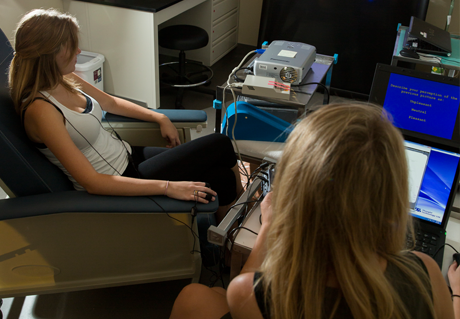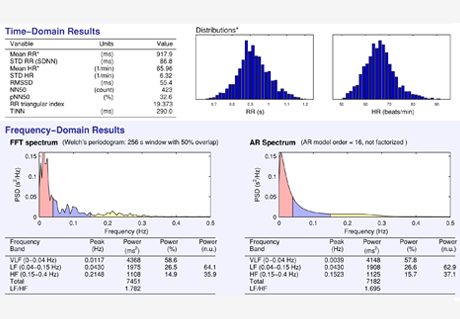Biofeedback Laboratory

Breathing exercises facilitated by biofeedback are used to increase the variability of your hearts rhythm. Increased heart rate variability is associated with a healthier cardiovascular system. These exercises, if practiced regularly, will help you respond to stressors in a healthier way by using breathing as a way to increase parasympathetic drive.
We can also use biofeedback to help you decrease tension in the muscles in your back and neck. These are the muscles that are usually very tense when you are feeling stressed.

Biofeedback Breathing Training
Objective of Biofeedback Breathing Training
Biofeedback training can help teach you how to more effectively respond to stressors in your life. This training helps to increase awareness and control of your mental and physical response to internal and external stressors. This awareness will enable you to control your response to stress just by taking deeper and slower breaths when you feel anxious or afraid.
Objective of the Breathing Technique that We Teach
Resonance breathing training a technique that is used to synchronize your hearts rhythm with your breathing. You can change the variability and dominant rhythm of your heart's activity with practice. Biofeedback equipment gives us a measure of the quality, amplitude and regularity of the variation of your heart's rhythm as well as your respiration pattern. It gives us a measure of synchrony between your cardiac and respiratory system. When you inhale your heart rate should go up, when you exhale your heart rate should slow down.
How Do We Do this Training?
It is very simple, as simple as breathing. Remember when your mom told you, slow down just take a deep breathe. What we are doing is similar, only a little more sophisticated. We will use a pacer to control your breathing rate. It will take few minutes to achieve coherence or synchrony between your breathing pattern and your heart rate. We will practice gradually, beginning at 8 breaths per min, then 7, then 6. We want you to take slow, deep breaths. For most people, the optimum breathing rate will be around 5-7 breaths per minute. With practice it will require less effort and conscious attention.
What Kind of Breathing Technique Should You Practice at Home?
Slow deep breaths like the ones we are doing today for 10 min a day, 2 times a day. We will also give you a hand-out on other techniques that you can practice at home: diaphragmatic breathing; pursed lip breathing; and sustained maximal inspiration. The important thing is to just practice these for a few min, 2 times a day. I think that you will find that you will naturally respond to stressors in your life differently. Rather than allowing your heart rate to accelerate rapidly to a stressor, you will respond by taking slow deep breaths. It is just what mom told you to do.
Faculty
Department of Kinesiology & Sport Management
-
Address
Box 43011, Texas Tech University, 2500 Broadway, Lubbock, TX 79409 -
Phone
806.742.3371
